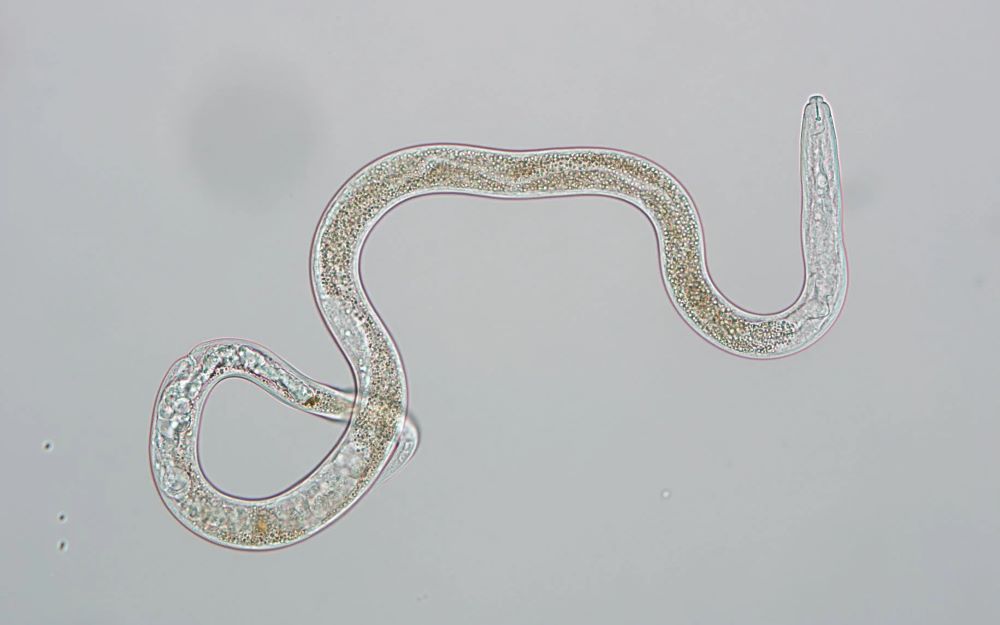The Body Scientific
Beech Leaf Disease and Nematodes
By Richard Kessin

A microscopic image of the nematode that infects beech trees.
I am used to studying diseases of animals. Like humans, vertebrates have immune systems and cells like macrophages that roam through the body to eat invaders. Trees are a whole other category: They do not make antibodies to protect themselves and they certainly cannot run away from a threat. Trees do have defenses: Strong bark and the ability to make toxic chemicals (think opioids and nicotine) to deter invaders. These are not always successful.
Consider beech leaf disease, which appears to be caused by a nematode or worm. Except that is not as simple to prove as we would like, a point made by Robert Marra Ph.D., a plant pathologist with the Connecticut Agricultural Experiment Station (CAES) during a recent talk in Norfolk.
Scientists have established standards for defining whether an organism causes disease. In this case, the right kind of nematode must be isolated from an infected beech tree, cultured independently and then cause an infection when introduced to a healthy or uninfected tree.
These criteria are called Koch’s postulates in honor of Robert Koch, the German microbiologist, who formulated them. Even a great scientist like Louis Pasteur can make a mistake—he thought rabies was caused by bacteria rather than a virus.
Back to our nematodes. They are round worms that come in astonishing varieties and may be among the most abundant invertebrate organisms on earth. They can do good by turning over nutrients in the soil at a rapid pace, but also cause harm. They are responsible for river blindness in Africa and heart worm in dogs, both of which can be treated with a drug called Ivermectin made by Merck that kills the larvae.
Nematodes have also powered scientific research. Sixty years ago, when the legendary Sydney Brenner wanted an animal to study development, he turned to the humble round worm. Brenner’s ideal organism had to be small and grow fast. It had to have a genetic system so that mutations and their effects could be watched over generations. As luck would it, nematodes are conveniently transparent and can be viewed through a microscope. Each nematode has about 1,200 cells, including neurons. They move fast and climb but are tough to kill. Thanks to Brenner, we also know a lot about nematodes.
What of the beech tree nematode? It is called Litylenchus crenatae mccannii and has the same shape and characteristics as the worm studied by Brenner and hundreds of other scientists. Marra and his colleagues have described the current understanding of how to manage the nematode (see adjacent story). The bottom line is that options are limited and involve going tree by tree.
As a scientist, I am worried about larger ecological effects and wanted to learn more. Early in the growing season the beech leaf nematode inserts itself between the leaflets of a bud and causes dark green streaks in the developing leaves. By using a scanning electron microscope, Marra’s lab showed the interior structure of an infected leaf is devastated, leaving strands of what could be cellulose.
Using a conventional light microscope at the Norfolk Hub, some friends and I tried (and failed) to see nematodes in the leaves through our light microscope. We later learned that if a striated beech leaf was placed in water, an enormous numbers of nematodes emerged. This appeared to satisfy Koch’s postulates.
I think the best way to learn more about these pests is to use the microscope at the Norfolk Hub and time lapse photography to watch the nematodes emerge. At that point we can grow the nematodes on Petri dishes and do simple experiments. If they don’t eat a leaf, what do they eat? There is a lot to discuss about this parasite. To be arranged!
Learn More about Beech Leaf Disease
Researchers at the Connecticut Agricultural Experiment Station in New Haven have put together detailed resources about beech leaf disease and the nematode that causes it. Some of these materials are on display at the Norfolk Hub, but you can also download information about how to identify diseased trees and available treatment options.
Visit https://portal.ct.gov, search on beech leaf disease. You will learn that it was first detected in Connecticut in 2019 and in neighboring Rhode Island the following year. Beech trees are foundational in New England forests, providing both shade and nourishment for a host of animals. Infected trees may die within four years.
Management options include treating individual trees with potassium phosphite and potassium polyphosphite fertilizers. Researchers in Ohio found that the treatment improved the tree’s ability to defend itself and reduces the impact of the nematodes.

I will be thankful if you credit this nematode image to the right author. This image was taken by Paulo Vieira, USDA-ARS.
Many thanks,
Paulo Vieira
Thank you for letting us know!